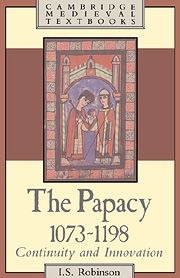Book contents
10 - The papacy and the Normans
Published online by Cambridge University Press: 05 June 2012
Summary
The building of the Norman principalities in southern Italy and Sicily and the papal reform movement – two of the most influential enterprises of eleventh-century western Christendom – were intimately connected. Similarly the creation of a single Norman kingdom of Sicily in the twelfth century and the strivings of the papacy for political independence and security were closely related developments. The connecting thread was the feudal relationship which bound the Norman princes to the pope as their secular lord. The constitutional history of the Norman principalities, and of the Norman kingdom into which they were absorbed, is recorded in a series of oaths of fealty sworn to the apostolic see and in a series of papal privileges outlining the vassal duties of the Norman rulers. Here was the only region, other than the Patrimony of St Peter, where the claims of the papacy to feudal overlordship could be of practical significance. The relations of the popes with their Norman neighbours and vassals offer a unique insight into the feudal theory of the papal curia.
The immediate impression is of the vast discrepancy between papal claims and political realities in southern Italy. Throughout the period of Norman domination in southern Italy the papacy experienced political reversals and territorial losses at the hands of its Norman vassals. On three occasions – in 1053, 1139 and 1156 – a pope led an army in person against the Normans and suffered the humiliation of defeat and capture.
- Type
- Chapter
- Information
- The Papacy, 1073–1198Continuity and Innovation, pp. 367 - 397Publisher: Cambridge University PressPrint publication year: 1990



